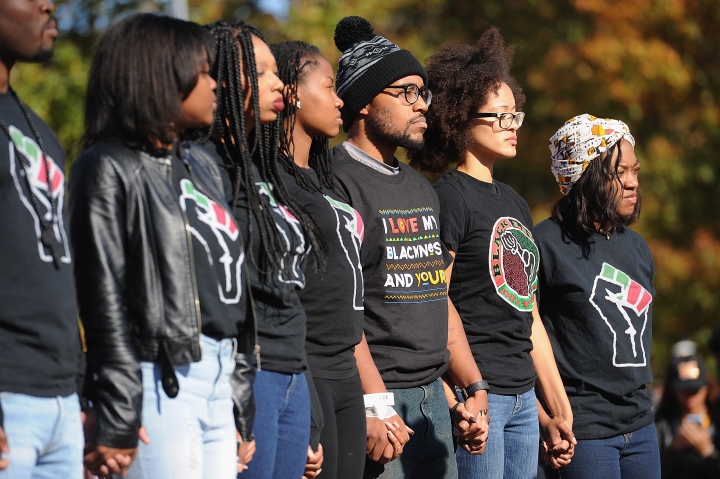In case you missed it in these past few weeks, attending a university is yet another thing people of color cannot do in the U.S. Between Mizzou and Harvard, the message of exclusion for people of color in higher academia has been made loud and clear.

COLUMBIA, MO – NOVEMBER 9: Jonathan Butler (c), a University of Missouri grad student who did a 7 day hunger strike listens during a forum speaking to students on the campus of University of Missouri – Columbia on November 9, 2015 in Columbia, Missouri. Students celebrate the resignation of University of Missouri System President Tim Wolfe amid allegations of racism. (Photo by Michael B. Thomas/Getty Images)
In response to widespread racism and discrimination against black students on Mizzou’s campus, several students rallied together to demand focus on the reality of living as black students on predominately white institutions (PWIs). As several voices have pointed out, protests like these are nothing new; students of color (and their allies) across the country have demanded attention to bring change and awareness to their campus communities.

In this particular case though, the backlash from the protests at Mizzou have highlighted why black voices remain silenced in largely white spaces. Conservative pundits, color blind well-meaning white people, and even outwardly racist folks alike were quick to shame protesters for voicing their concerns, accusing protesters of ignoring other issues around the world.

Meanwhile, the blatant acts of racism on Harvard’s campus demonstrate the reality that blacks are especially excluded from ivy league institutions which have been built upon the notorious legacies that founded this country. The irrational fear, grounded solely in illusions of white privilege, has emboldened white students, born of this legacy of hatred, to commit hateful (yet cowardly) acts on college campuses.
The seemingly inherent fear of blacks somehow diluting the pure prestige of ivy league schools has trained many white college students to believe that racism and discrimination are normal aspects of college culture. An NPR story on the future of Mizzou after the protests featured an interview with a white student.
“I honestly want these protests to try and die down,” he says. “I want the message to continue, but I think it’s attracting a lot of unnecessary national attention from just everywhere. And it’s giving Mizzou a bad image in my opinion … I don’t think we deserve what’s going on right now. I just kind of want things to go back to normal, how they were. Nice and quiet.”
Many of the phrases used here are elements of coded language that get thrown around in an effort to lessen the sting of racism (and make white people more comfortable with expressing their ideas publicly.) The idea of a “normal” highlights the lack of awareness of students who don’t understand what it’s like to feel unsafe in most spaces. The privilege of power extends to these students when they can walk freely to class instead of avoiding potentially fatal threats on campus.
While the issues surrounding these recent incidents remain, it’s clear that the next generation of leaders refuse to allow racism to subtly coat the surface of academic spaces. The black lives matter movement has continued to gain momentum, despite it’s inner struggle in grappling with intersectionality. In order to see true change in public spaces, the uncomfortable conversations about race must continue.
Otherwise, things might just go back to how they were. Nice and quiet.








